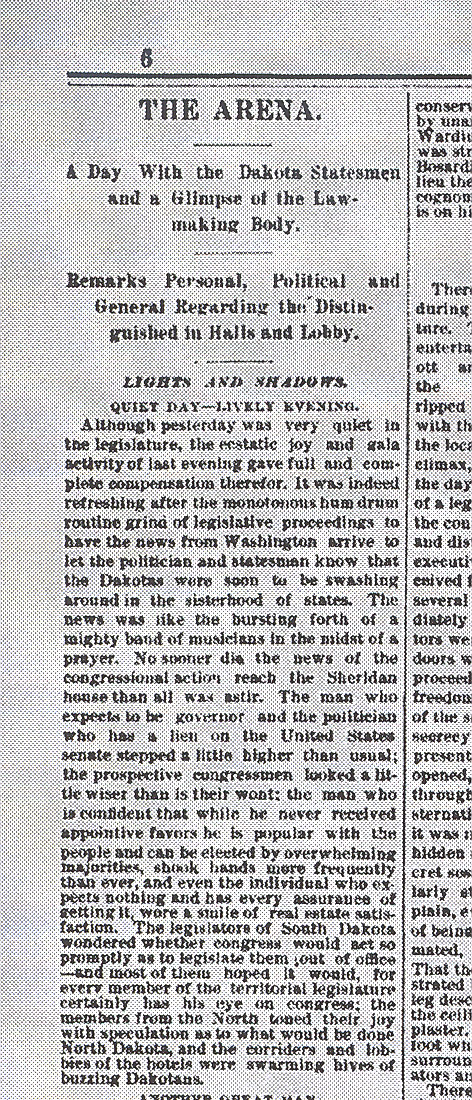Beginning in 1871, the people of Dakota Territory agitated for statehood. The people assumed that the territory would become two states with the dividing line at the 46th parallel of latitude.
Congress had entertained the idea of statehood for Dakota Territory for many years. Different statehood bills were introduced, but none of the bills had enough support to become law until 1889.
The territory faced both local resistance to statehood and national political complications. There was little support among the residents of the territory until after the capital was moved to Bismarck. The collusion of Governor Ordway in this political decision caused many people to wish an end to presidentially appointed governors. The railroads also opposed statehood. The Northern Pacific Railroad had more political control and less regulation with a territory than a state. The railroads enjoyed great influence over the territorial government and in Congress.
Dakota Territory’s voters were mostly Republicans. Republicans in Congress would have happily admitted a Republican state, but from 1884 to early 1889, Democrats controlled the House of Representatives and the Presidency. Grover Cleveland, who was president in 1888, was the only Democratic president between 1861 and 1913. The Democrats wanted to continue their control of the House of Representatives and wanted to admit states that had a mostly Democratic population. For that reason, the Democratic Congress was reluctant to grant statehood to North Dakota.
In the general election of 1888, Republicans won the Presidency with Benjamin Harrison. Democrats in the House of Representatives realized that they had to act to bring new territories into the Union hoping that they could win some friends in the new states. Democrats tried to manipulate the political process in their favor, but their efforts were clearly not in the best interests of the territory or the nation. Representative C. H. Grosvenor of Ohio declared that the people of the United States felt that Congress had not acted in good faith on the matter of the territories waiting for admission. In 1888, Grosvenor declared that “for lo these four full years of Democratic administration the Territory of Dakota has been ready for Admission to the Union. She has been kept out of the Union because she is not barbarous and treacherous, nor Democratic. She has been kept out of the union with hope that the power of the Democratic party might be projected four more years. . . .””
In the end, the Democrats’ attempts to create a few friends among the territories failed. Shortly before President Harrison took office, the House of Representatives and the Senate finally agreed upon a bill called the Omnibus Bill. It had taken several months to gain acceptance in Congress, but finally passed on February 22, 1889. This bill, also called the Enabling Act, provided for the admission of four states: North Dakota, South Dakota, Montana, and Washington. All four were, for the most part, Republican states.

President Grover Cleveland signed the Omnibus Bill immediately. (See Document 1) The Omnibus Bill provided careful directions for the division of Dakota Territory into two states. The states had to figure out how to divide the property, records, and debts between North and South Dakota. Each new state was to conduct a constitutional convention beginning on July 4, 1889, and to send the constitution to the voters on October 1, 1889. If the voters refused to accept the constitutions, the state would not be admitted to the Union, and North Dakota would remain a territory.
When North Dakota had completed its designated tasks and the people had approved the Constitution, President Benjamin Harrison signed the Act of Admission on November 2, 1889. The President’s signature made statehood official. However, Harrison did not want to show favoritism to either North Dakota or South Dakota. After he signed the Act, he mixed up the papers so it would be impossible to know which state entered the Union first. The states are often listed in order of the date of their admission to the Union, but the Dakotas are listed alphabetically. North Dakota is listed as the 39th state and South Dakota is listed as the 40th state.
Why is this important?It is likely that North Dakota would have become a state several years earlier if the national political parties had not been trying to damage one another. The state had sufficient population and many people were eager for statehood.
On the other hand, the slow and deliberate process by which Congress and the President admitted North Dakota to statehood ensured that the territory would be divided into two states. With the guidance of the Omnibus Bill, the people of the new state constructed a proper constitution that protected the rights of the citizens and provided for a functional government.
Source: Frederick Logan Paxson, “The Admission of the “Omnibus” States 1889 – 1890,” in Proceedings of the State Historical Society of Wisconsin (1911): 77-96. Available online.


